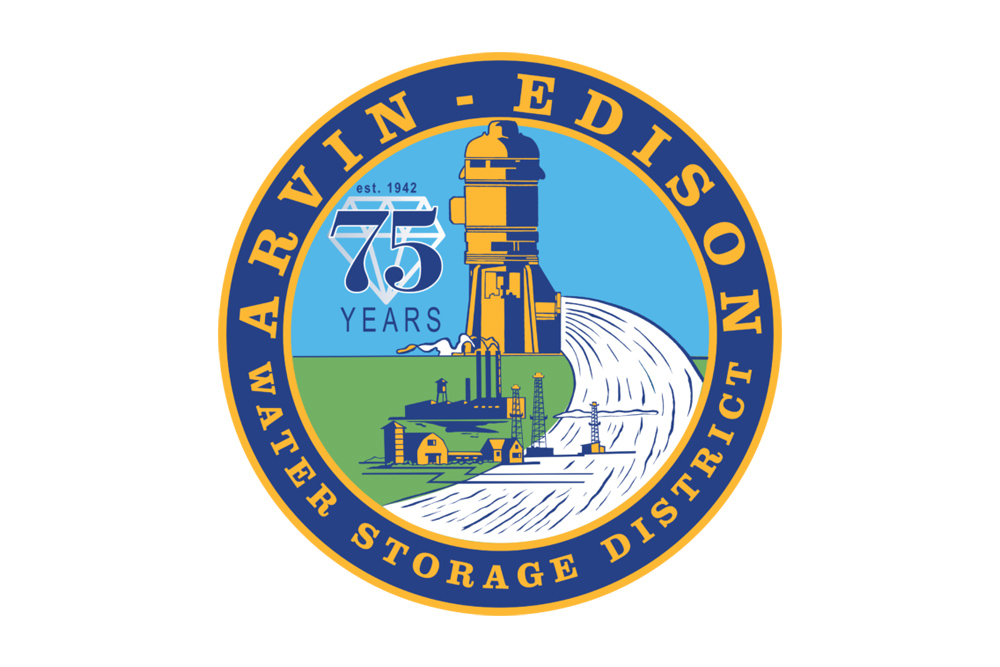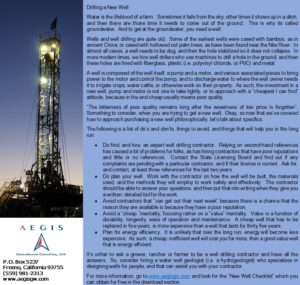 The Tulare Irrigation District held its board of directors meeting on Tuesday, September 11, 2018 at its headquarters somewhere west of town. I got a little behind sending out an Instagram about TID’s new spray truck. They couldn’t find one with the featured they wanted so they fabricated one at the district’s shop. Looks good. Chairman Dave Bixler called the meeting to order at 9:00 am. There were no changes to the agenda and the minutes were approved with minor changes.
The Tulare Irrigation District held its board of directors meeting on Tuesday, September 11, 2018 at its headquarters somewhere west of town. I got a little behind sending out an Instagram about TID’s new spray truck. They couldn’t find one with the featured they wanted so they fabricated one at the district’s shop. Looks good. Chairman Dave Bixler called the meeting to order at 9:00 am. There were no changes to the agenda and the minutes were approved with minor changes.
Water Report
Marco Crenshaw, Watermaster gave his report saying storage at Terminus is 15,000 a/f of a  possible 185,000 a/f. There was some discussion about the hydropower operations. One of the things about California’s government is its unwillingness to live in reality. Governor Jerry Brown declared the state will be completely free of fossil fuel electricity generation by 2040. Yet, the state doesn’t consider hydroelectricity a clean, renewable source of power. Which makes the operations and financing of power plants difficult to plan. General Manager Aaron Fukuda said TID can offer tertiary water delivery but can not be used for recharge. It can be used for irrigation and channel lose is OK as is loss at regulation basins. But no recharge. The water has to keep moving. I believe the price will be $45.00 per acre foot or whatever the district rate may be. Not bad. This supply can be tacked on to flood releases and this program will begin in October with a ground breaking ceremony with the Mayor of Visalia, the source.
possible 185,000 a/f. There was some discussion about the hydropower operations. One of the things about California’s government is its unwillingness to live in reality. Governor Jerry Brown declared the state will be completely free of fossil fuel electricity generation by 2040. Yet, the state doesn’t consider hydroelectricity a clean, renewable source of power. Which makes the operations and financing of power plants difficult to plan. General Manager Aaron Fukuda said TID can offer tertiary water delivery but can not be used for recharge. It can be used for irrigation and channel lose is OK as is loss at regulation basins. But no recharge. The water has to keep moving. I believe the price will be $45.00 per acre foot or whatever the district rate may be. Not bad. This supply can be tacked on to flood releases and this program will begin in October with a ground breaking ceremony with the Mayor of Visalia, the source.
Maintenance Report
TID Superintendent Wayne Fox, sounds like a super hero’s civilian name, gave his report saying mowing and grading is underway. The basins are being disked starting eastside to west. The district will soon have a new grader as well. New spray truck and grader in one season – staff must be happy. Something’s going on in world of cement. Old concrete for rip rap is starting to get hard to find. There is a lot of old concert in dairies being shut down but that stuff is getting hard to find because there’s now a market for ground up concrete. Fox also said it is cheaper to plow up a basin with a rental tractor than a districts tractor. He said there is a good deal of metal and if the district’s tractor blows a tire it costs $5,000. A blown tire on a rental is more like $1,300. Fukuda said some data shows once the basin is prepared moving any heavy equipment is discouraged. This isn’t carved in stone but it can compact the soil and retard recharge. Director Dave Martin said compaction with a big, duel wheel tractor won’t compact much. Director Rick Borges agreed compaction doesn’t have to be a problem. Martin suggested fencing off the basin, let them get weedy and bring in goats. A friend of mine, Geoff Vanden Heuvel used to live in Chino. He was at the meeting and said they used goats down there to good effect. Martin was happy to hear his idea validated. Here’s some good news for someone – TID is looking to hire more workers. Fox handed out a report on what TID vehicles are about to become noncompliant with the California Air Resources Board guidelines. He listed six trucks and when they will go out of order between January 1st, 2019 and January 1st, 2023. Martin is on the equipment committee and recommended purchasing a 2019 Western Star 4700 PB Loader for about $150,000 from Fresno Truck Center and the board agreed.
Treasurer’s Report
The treasurer’s report was next and controller Kathi Artis gave her report. I hope I’m not stepping over any lines but respectfully Ms. Artis’ new hairdo is very flattering. Good for her. I realize I don’t often give much detail in the financial areas. It’s difficult to follow, read and type with much accuracy and since this is all public record it’s not a secrete being withheld. But that doesn’t mean the treasurers, controllers and bookkeepers aren’t working diligently on behave of the public to keep the financial records straight. Sometimes there are interesting things that stand out and grab my attention but I think it’s a testament to the special districts dealing in water that there are very little problems in that area. And it’s true, Ms. Artis is a nice lady and her hair looks great. So, yes that’s filler but sincere filler and I think more interesting than a completely routine financial report.
 The board looked over the bills and being farmers they appreciated the balanced frugality. Boards comprised of all farmers traditionally look over the bills a lot closer than other boards. Not because they don’t trust staff but, I think because they’re farmers they enjoy saying things like, “I could have got that bushing $.27 cheaper.” They did question why a pair of work boots were billed to the district and if they were hand made by a cobbler. I didn’t follow the entire thread of the conversation evidently one of the perks of working at TID is an annual boot allowance of $150 that is given in August. The board finally approved all the reports.
The board looked over the bills and being farmers they appreciated the balanced frugality. Boards comprised of all farmers traditionally look over the bills a lot closer than other boards. Not because they don’t trust staff but, I think because they’re farmers they enjoy saying things like, “I could have got that bushing $.27 cheaper.” They did question why a pair of work boots were billed to the district and if they were hand made by a cobbler. I didn’t follow the entire thread of the conversation evidently one of the perks of working at TID is an annual boot allowance of $150 that is given in August. The board finally approved all the reports.
Manager Report
Fukuda said there wasn’t a GSA coordination meeting in the Kaweah Sub Basin. He said the consultants were put on notice the progress has been too slow. Within hours a flurry of meetings were scheduled and many of them are Technical Advisory Committee meetings. The base period for analysis was agreed to be 1999-2017. The engineering consultants GEI are proposing management zones and there is talk on the minimum thresholds. The San Joaquin River settlement and climate change  prognostications have to be figured in and this means the true history of the area won’t be an accurate mirror to view what’s coming. Crenshaw said higher temperatures are going down and lower temperatures are going up enough to pull the average up. Other Mid Kaweah GSA news; the excellent Valerie Kincaid has been hired as attorney and the budget went up to $1.2 million. I’m sure the two items are not related. There are hints of political intrigue by some of the urban members of MKGSA. I wasn’t at the last meeting but there appears to be a left leaning, enviro letting emotions rule. A man wants to retire farmland in the best producing area on earth. Tattoo parlors, bistros and Starbucks won’t keep the City of Tulare going.
prognostications have to be figured in and this means the true history of the area won’t be an accurate mirror to view what’s coming. Crenshaw said higher temperatures are going down and lower temperatures are going up enough to pull the average up. Other Mid Kaweah GSA news; the excellent Valerie Kincaid has been hired as attorney and the budget went up to $1.2 million. I’m sure the two items are not related. There are hints of political intrigue by some of the urban members of MKGSA. I wasn’t at the last meeting but there appears to be a left leaning, enviro letting emotions rule. A man wants to retire farmland in the best producing area on earth. Tattoo parlors, bistros and Starbucks won’t keep the City of Tulare going.
Fukuda showed what GEI came up with for undesirable results. The main one to avoid was lowering groundwater levels and maybe a little subsidence. Management areas are gaining popularity and will be called hydrologic zones. The groundwater contours are the guide to parceling out the management area boundaries. But that causes squiggly lines that are difficult to manage so it will be rounded, rather squared off by sections. There was talk about inflow and outflow. It has been said there are two models in the Tulare Lake bottom, one GSA and one by Boswell. This isn’t a case of the greedy corporate ag sponsoring cooked books, it’s a prime example of protecting oneself against the gobberment. Back to MKGSA, Fukuda said he’s pretty much in agreement with GEI’s latest proposal.
Martin commented both Visalia and Tulare have gone nuts with building. He said if he has to fallow 20 percent of its lands the cities need to close 20 percent of its businesses. Tulare has TID to get surface supplies but Visalia doesn’t have surface water to grow.
Friant
Fukuda said the subsidence issue on the Friant Kern Canal is moving quickly. He said while the middle reach of the FKC is the most serious there are still problems with the upper and lower reaches. One of the problems is the bridges of county roads going over the canals. I understand the counties are rather lackadaisical about the matter ostensibly because the roads were there first and the USBR is supposed to take care of this matter. One of the recent snags is running a bypass east of the canal but that area is also sinking. Raising the banks, widening the canal and pump stations amongst other measures are under consideration. In-line pump stations with new canal lining was also a popular option along with pressurized pipelines down the canal bed. There will be a workshop on the options coming up with Stantec there to explain things. As for paying for it the only Friant contractor that has stated it won’t pay for a FKC fix is Fresno ID. Someone asked if FID opts out of helping who get’s its water? It was also said Chowchilla WD and Madera ID might have a case for opting out. I’d throw in Gravely Ford ID as well. FID is a Class II member trying to protect its growers by doing what it considers fiscally prudent.
Temp Flat
Fukuda is a major player in the new Temperance Flat JPA. The language of the joint powers  authority has been drafted and needs to be vetted. This is a transition period for the representation of Temp Flat. The San Joaquin Valley Water Infrastructure Authority JPA that got Temp Flat in the Prop One race will go on to other things. The new JPA will be made up of the current MOA investors group with activity agreements and other members coming on board. This can all be amended and modified in the future. Borges said there are entities that will try to get water out of it who have never received Friant water before so watch out how this is put together.
authority has been drafted and needs to be vetted. This is a transition period for the representation of Temp Flat. The San Joaquin Valley Water Infrastructure Authority JPA that got Temp Flat in the Prop One race will go on to other things. The new JPA will be made up of the current MOA investors group with activity agreements and other members coming on board. This can all be amended and modified in the future. Borges said there are entities that will try to get water out of it who have never received Friant water before so watch out how this is put together.
Other Stuff
Fukuda said the Okieville Project did not receive early funding from FEMA. FEMA won’t do it without an environmental review first. A property owner Stephen Fagundes wants a new letter of intent and a lease for a year to keep the parcel needed for the project’s infrastructure available for later. Fagundes said the value of the property has increased and there was a good deal of disagreement on that. A new appraisal will settle things, hopefully.
The meeting then opened as the board of equalization. This will last until next month. The board then appointed alternates to the Mid Kaweah GSA. One board member, an alternate and Fukuda as the alternate if both of those guys are out of the game for the day. So, Martin will be the member and Director Scott Rodgers will be the elected alternate with Fukuda as the unelected alternate.
Under board reports Bixler and Borges had nothing. Martin spoke about the NASA Airborne Snow Observatory. If the grant comes into play the Kaweah St. John Rivers Association says yes.
The meeting then went into closed session for some personnel, real estate and legal cases.
DISCLAIMER OF RESPONSIBILITY; Waterwrights strives to provide his clients with the most complete, up-to-date, and accurate information available. Nevertheless, Waterwrights does not serve as a guarantor of the accuracy or completeness of the information provided, and specifically disclaims any and all responsibility for information that is not accurate, up-to-date, or complete. Waterwrights’ clients therefore rely on the accuracy, completeness and timeliness of information from Waterwrights entirely at their own risk. The opinions expressed in this report are those of the author and do not represent any advertisers or third parties.
ALL RIGHTS RESERVED. Copyright 2018 by Don A. Wright
TULARE IRRIGATION DISTRICT
6826 Ave 240, Tulare, CA 93274 Office: 559/686-3425
Board: David G. Bixler- President, Richard S. Borges, Jr.-Vice President, Scott Rogers, Dave Martin & Michael Thomas
Staff: Aaron Fukuda-General Manager, Bill Sario-Engineer, Kathi Artis–District Controller, Wayne Fox–Superintendent, Marco Crenshaw–District Watermaster & Alex Peltzer-Attorney, Engineering Intern-Jeremy Barroll who looks a lot like a young Fred Arminson, so maybe that’s why you think you know him.
About: The Tulare Irrigation District was organized September 21, 1889. The original proposal for the formation of an irrigation district covering 219,000 acres, extending from the Sierra Nevada foothills to Tulare Lake, was eventually reduced to 32,500 acres. The District continued in this status until January of 1948 when the so-called Kaweah Lands” (approximately 11,000 acres) were annexed. In October of 1948, approximately 31,000 acres, compromising the area served by the Packwood Canal Company were annexed to the District. A U.S. Bureau of Reclamation contract was signed in 1950 providing an annual supply of 30,000 acre-feet of Class 1 water, and up to 141,000 acre-feet of Class 2 water from the Friant-Kern Canal. The District and the Kaweah Delta Water Conservation District have coordinated efforts to enhance the recharge of groundwater within the Kaweah Basin. During high flow times KDWCD may use the recharge basins with the District for recharge purposes. Further, KDWCD has historically provided for a financial incentive program through which the District sustains the level of groundwater recharge from supply sources into the District. This historical program was recently reinstated by both districts in lieu of the District’s plans to concrete-line this canal to conserve the surface water. TID is a member of the Mid Kaweah GSA.

































